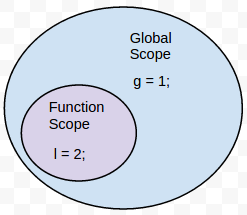This repository contains JavaScript Closure demo.
Before we start talking about the closures, it is important that we understand the following terms, because these will form the baseline of our entire understanding on closures:
1. Lexical Scope
Lexical means language or text. Scope means property related to text. Lexical Scope is basically defined by function's physical placement in the written source code.
In JavaScript, let's understand the scope of variables:
var g = 1;
function sum() {
var l = 2;
return g + l;
}Now, let's try to represent this code in the form of a diagram:
In JavaScript there is function scope. This means that a variable defined inside a function is not visible outside the function. But, the variable defined in a code block say if/else or for loop then its get visible in whole function because that variable is also defined in function scope( Javascript does not have block scope).
This means that we can access local variable 'l' inside the function sum only, outside the sum function we can access only global variable 'g'.
Let's see through the following table what would be the output out side the sum function in the given cases:
| Snippet | Output | Explanation |
|---|---|---|
| g; | 1 | 'g' is global variable so we can be access 'g' variable everywhere. |
| l; | undefined | 'l' is local variable of function sum, so can't be access outside the function sum. |
| sum(); | 3 | Since 'g' is accessible into the function sum, therefore we get the correct result |
2. Scope Chain
The second most important thing that we need to understand while working with concept of closures is 'chaining' or 'scope chain'. Suppose a function is defined inside a function, then, it will have access to variable in its own scope as well as the in the scope of its parents. This is known as scope chain.
Let's see the following snippet and you would be able to understand:
var grandFatherName = "John";
function father() {
var fatherName = "Devis";
function child() {
var childName = "Tom";
var description = "My name is" + childName + " ,my grandfather is " + grandfatherName + " and my father is " + fatherName;
return description;
}
return child();
}
console.log(father());O/P would be My name is Tom , my grandfather is John and my father is Devis
The example above is self explanatory though, but still I would like to give a brief description:
father is the outer function that contains variable fatherName. child is a function inside the function father which has a variable childName and description. In the variable description we are accessing variable fatherName and grandFatherName. grandFatherName is a global variable, hence it would be accessible everywhere while fatherName is a local variable in function father but it is still accessible to function child as child has access not only to the variables in its own lexical scope but also in its parents!
Now, let’s take the things further and put some light on closures, have a look at the following code:
var a = 2;
var f = function (param1) {
var b = param1;
var n = function () {
var c = 10;
var d = a + b + c;
return d;
}
return n;
};
var k = f(20);
var m = f(30);
console.log(k());
console.log(m());So if we try to diagrammatically explain the above snippet, it would be something like:
Does this mean that inner function 'n' still has access to the outer function 'f'. Yes you are right! When any inner function get out from outer function then it takes the snapshot of the outer function with it, hence it is able to access the value of variable 'b' outside its own lexical scope. Hence we correctly get the result!
So to sum up, closure is nothing but a function defined inside another function. Inner function is closure. It is important to remember that when an outer function returns an inner function or assign inner function to some global or non local variable of outer function, then it captures a snapshot of the outer function with it.
Now, let's test our understanding a little bit more:
See the following piece of code:
var name;
function person(a, n) {
var age = a;
name = n;
return function () {
console.log(age, name)
};
}
var amit = person(25, 'Amit');
var namita = person(23, 'Namita');
console.log(amit()); // 25 Namita
console.log(namita()); // 23 NamitaHere 'Namita' got printed as the result of the second last line instead of where we were expecting 'Amit'. This is because closures take the snapshot of the outer function and keep the reference of the global variables because global variables are accessible out side the outer function as well. Inner function/closure takes snapshot for those variable only which are not accessible out side the that function or which are private variable of outer function. Therefore when a reference variable modifies the value of global variable, the other reference variable pointing out to that global variable gets that modified/updated value.
Note: You can checkout full working source code from this link.
In the upcoming blog "More on closures" we will discuss more examples of closures and their implementations. Till then Happy Learning!


